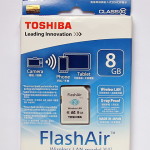Toshiba FlashAir, command line, retro machines and all
August 11th, 2014
A couple of weeks ago I didn’t even know that there are WLAN-enabled SD cards, but such beasts exist indeed. Usually they are meant for cameras and automatic uploading of recent photos, but a creative mind can quite obviously think of a lot of other uses for them. The most interesting product seems to be Toshiba FlashAir, since it allows file upload unlike most other devices. It’s not too expensive either, so I got myself the 8G model.
Instructions on setting up the card can be found on other sites. As a matter of fact, the documentation is surprisingly extensive. At its heart the card contains a web server that can be used for different transactions (plus those automatic uploads that I’m not interested in). It didn’t take much effort to edit the needed config file to get the gadget set up. After that you just need to find out its IP and start browsing. There are various hidden CGI files, such as upload.cgi, that let you do a number of things ranging from file browsing to configuration. They and their parameters are all described on the FlashAir Developers’ site.
I expected there to be some ready-made handy tool for file handling and maybe there is, but all I could find were various code snippets in Python or PHP. Browser-based file handling isn’t that great, so I ended up hacking together a little shell script called FA that lets you do the most needed basic stuff from the command line. Should work in any *nix, as long as you’re using bash and have cURL installed. Maybe even Cygwin or similar, who knows. Use as you wish, but don’t come complaining to me if your files were lost 🙂
The original reason for getting the card was to use it with various oldschool computers and their card readers. So far I’ve only tried Sinclair QL and it kind of works. The only remaining problem is that the card doesn’t deal well with reset: after that you need to reinsert it, which sort of beats the purpose of wireless data transfer. After reinserting the card it also takes about 10 seconds to be back online, which is a bit annoying if you need to wait for it frequently. I’ll update this post when I’ve experimented with other machines.
I’m sure there’s more to discover when dealing with other machine/card reader combinations. For example, I don’t know if the filesystem needs to be FAT32. If so, some readers will not work.
edit: Similar behavior with the 1541 Ultimate. Initially the card works like an angel, but after the C64 has accessed the virtual drive the web server disappears until the next cold boot or card reinsertion. Mere reset doesn’t help.
edit2: Another interesting discovery is the user IO mode, where you can control individual SD pins as you see fit. Could make an interesting wireless controller or something.
edit3: According to Tero’s tests, the card works better with a ZX Evolution. It seems that the Evo doesn’t kill the WLAN after a reset.

Kommentin kirjoitus
You must be logged in to post a comment.
RSS feed for comments on this post.